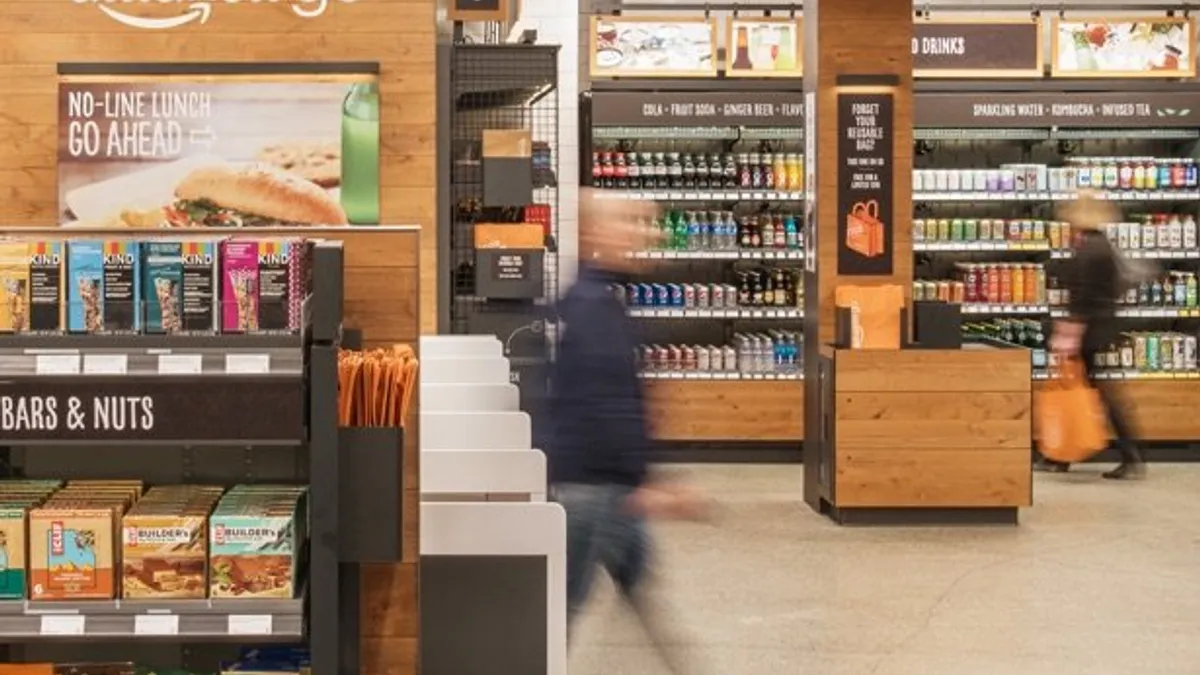Editor's Note: The following is a guest post by Jason Ankeny, content marketing director for Signal. The views are the author's own.
It's far from certain whether Amazon Go represents the future of shopping, but it certainly feels like shopping in the future.
The checkout-free convenience store's newest location in downtown Chicago — the first to open outside of Seattle — is every bit as high-tech as the advance scouting reports suggest. You enter its subway-style gate using your smartphone, scanning a personalized QR code embedded in the Amazon Go app, and as you browse the store's aisles, hundreds of hidden cameras and sensors track your every movement, automatically adding each item you select to the app's virtual cart (and removing any items you put back on the shelf). The inventory is dominated by grab-and-go merchandise (pre-made sandwiches and salads, protein bars, energy drinks, etc.), and when it's time to check out, you simply walk out: there are no cash registers, no cashiers and most importantly, no lines. Your purchase is billed to your Amazon Prime account, and your receipt is delivered directly to the app.
Amazon Go caps off your visit by sending a notification to your phone's lockscreen, in my case reading "Nice get up and go! Your trip time was 7m 41s." Efficiency and expediency are the store's primary selling points: there's nothing on its shelves you won't find elsewhere (well, almost nothing — there's a limited selection of Amazon-exclusive merchandise, including chocolate bars and Amazon Go coffee mugs reading "Just Walk Out Shopping"), and the prices are comparable to 7-Eleven and other chains. But had I not taken my sweet time strolling the store, familiarizing myself with its layout, snapping photos and chatting with staffers, I would have been in and out in a matter of moments — surely a compelling proposition for the busy downtown professionals likely to comprise much of Amazon Go's traffic.
Next time, I'll know more of what I need to know to complete my purchase faster. And with each subsequent visit, Amazon will know much more about me, too.
Amazon built its retail empire by collecting and leveraging first-party customer data to drive personalization at mass-market scale: the biggest reason the company is now valued at $1 trillion is not because it offers better products than its rivals, but because it knows its customers so intimately — not as audience segments, but as people it can identify on a one-to-one basis within its ecosystem. By gathering information and insight from each shopper interaction across devices and platforms, Amazon created one of the world's largest and most sophisticated identity graphs (a database that houses all known identifiers that correlate with individual customers), an asset it uses to continually refine and redefine the customer journey.
"A decade of Prime membership means Amazon already knows my digital shopping habits and preferences in minute detail, and with Amazon Go, it's gaining the same access to my brick-and-mortar behaviors."

A decade of Prime membership means Amazon already knows my digital shopping habits and preferences in minute detail, and with Amazon Go, it's gaining the same access to my brick-and-mortar behaviors. Think of all that Amazon learns each time I walk through Amazon Go's doors. It can quickly pinpoint my favorite grocery categories, brands and flavors. Based on which items I buy versus those I put back, it can determine which factors influence my shopping decisions, like price or nutritional value. Down the road, Amazon could make highly educated guesses on whether I'm a vegetarian, or suffer from food allergies.
It could remind me that I need milk, eggs or other staples that I haven't bought recently, or alert me that the milk I purchased a week ago is fast approaching its expiration date. It could even suggest recipes inspired by items in my cart at that moment or those I purchased on my previous visit, and offer a discount on the missing ingredient that ties the meal together. Given the depth and breadth of customer data at Amazon's fingertips, the possibilities for personalizing my experience across its platform — and for generating additional revenue — are endless.
Amazon isn't the only retailer leveraging its cross-channel shopper data to make the customer experience more seamless, more differentiated and more lucrative. Marketing automation platform Sailthru's new 2018 Retail Personalization Index awards top honors to Sephora, citing the cosmetics brand's "intelligent integration" across the web, mobile, email and in-store as well as its Beauty Insider Community and mobile app, which deliver "unique and multifaceted content and products that feel as personalized as your favorite shade of lipstick." Also high on Sailthru's list: The Body Shop, Urban Outfitters and Amazon archrival Walmart, the latter singled out for personalization strides like its "Popular near you" and "Buy together and save" product recommendation tools, along with moves to integrate its mobile app with its Walmart Pay biometric fast-checkout technology.
Like Amazon Go, the initiatives celebrated by Sailthru benefit retailers even more than they benefit consumers. Each new personalized service or solution generates enormous insight into each individual shopper, revealing their likes, their dislikes, their behaviors and so much more. All of it fuels even more contextually relevant customer experiences moving forward, building the kind of intense brand loyalty that never falls out of fashion. Even if the future of retail doesn't include QR codes, hidden cameras and sensors, Amazon Go's unprecedented capacity to explore the shopper psyche is undoubtedly a sign of things to come.











